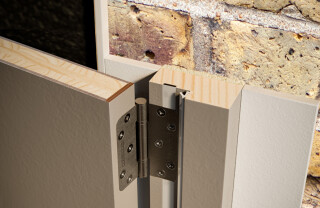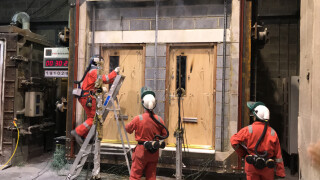It’s now more than three years since fire gutted Grenfell Tower in north Kensington, killing 72 people and igniting a furious nationwide debate over the possible causes, the likely culprits and alleged negligence at almost every level in the construction, refurbishment and maintenance of Britain’s high-rise housing stock.
We are still a long way from answering all the questions that Grenfell raised, but one thing that has become clear already is that the design, specification and installation of fire-resistant materials, including passive fire protection products, needs to be tightened up.
In June of this year it emerged that more than three-quarters of the fire doors inspected last year by the Fire Door Inspection Scheme were condemned as not fit for purpose.
Not only did 76% of fire doors fail the tests, but 63% of the buildings inspected also had other fire safety issues.
There were more than 100,000 inspections under the Fire Door Inspection Scheme (FDIS) in 2019 in over 2,700 buildings across the UK.
There are also clearly problems with fire-door installation as 30% of fire doors nationwide were condemned due to poor installation, with problems including excessive gaps around the door and the use of unsuitable foam.
This article was first published in the Jul/Aug 2020 issue of The Construction Index magazine. Sign up online.
According to FDIS manager Louise Halton, “the buildings that our inspectors visit include sleeping accommodation and those that house the elderly, the disabled and people with mobility or cognitive needs – some of the most vulnerable in our society. However, the latest data shows that the vast majority of fire doors are not fit for purpose.
“This paints a very worrying picture of the fire safety of the UK’s buildings, and one that we must all play a role in changing for the better to help protect lives,” adds Halton.
The data also found that 57% of installed fire doors inspected needed small-scale maintenance, with the top three reasons for failures including excessive gaps, smoke sealing issues and poorly adjusted door closers, which would prevent the door performing as designed to hold back the spread of a fire.
Independent third-party certification of manufacturers is pretty useless if installers and facilities managers do not know what they are doing. Of the buildings inspected, only 24% of fire doors that were third-party certificated were correctly installed and maintained, while 40% of third-party certificated fire doors were condemned due to poor maintenance and 36% due to both poor installation and poor maintenance.
Halton adds: “The biggest concern for our inspectors is the lack of knowledge that people have about fire doors. For example, third-party certificated fire doors provide crucial specification information and proof of performance for building owners, but if they are incorrectly installed or not maintained, they will not perform as designed and prevent the spread of fire.
“The correct specification, installation and ongoing maintenance of a fire door can really mean the difference between life or death for occupants, so it’s vital that building owners take responsibility and ensure that their fire doors are regularly inspected and maintained so as to save lives.”
These shocking revelations are greeted with dismay by the manufacturers of fire doors and associated products. Such a high rate of failure reflects badly on them and their products – and yet they have no control over how their products are installed or maintained in service.
Halspan, one of the UK’s best-known manufacturers of fire-door blanks launched two new products just one week after the FDIS published its report.
The new door blanks – dubbed the ProTech XT and IT – were developed in direct response to the aftermath of the Grenfell Tower fire and Halspan clearly hoped that they would help inspire confidence that at least one part of the construction industry was taking positive steps to improve fire performance in buildings.

He is referring to Hackitt’s comment that “There needs to be a golden thread for all complex and high-risk building projects so that the original design intent is preserved and recorded, and…any changes go through a formal review process involving people who are competent and who understand the key features of the design.”
Williams adds that “Grenfell sparked a wider focus on all aspects of passive and active fire protection. We are responding to this; we wanted to come up with products that will help the sector follow that golden thread”.
Halspan claims to have been the first manufacturer of door blanks to offer a full range of testing – not just on one door blank, but on the widest possible range of door configurations. Williams says that the company has carried out around 650 different tests on its products over the years.
But he admits that once one of Halspan’s blanks has left the factory, the company has no control over how it is used. “Twenty or 30 years ago, if you wanted a fire door you’d go to a fabricator and buy a doorset. We entered the market and started to compete by selling our blanks to joiners and other trades to make up their own doors,” explains Williams.
Today the company sells across the board, with customers ranging from jobbing builders to the largest doorset manufacturers.

“We want our product to be correctly presented – we do our best with due diligence, testing, certification, etc, but we have no control beyond our own product,” he says. “The leaf is made in one factory, the frame in another and the hardware in yet another. There are a number of ways in which co-ordination can lose track.”

“If the leaf is 824mm wide and the installed frame is 834mm, you’ll end up with a 5mm gap. It’s no one person’s fault, but it’s getting all the bits co-ordinated on-site that’s the problem,” adds Williams.
Training – which Halspan can provide – is key to reducing sub-standard installations, says Williams. But Halspan is also using technology to try and reduce errors further along the supply chain.
In what it claims is an industry first, every one of Halspan’s new XT and IT door blanks is supplied with a unique label and QR code which, when scanned, opens up a detailed installation guide showing exactly how to install the doorset or door assembly. It also identifies which hardware and seals to use and, crucially, includes instructions for the correct maintenance regimes.

“Hospitals and schools probably have the greatest concentration of fire doors; they also get the most abuse,” he says. When trolleys are used as battering rams or kids bash doors open in school corridors, the capacity for a fire door to perform as designed can be quickly compromised.
A fire door can also be rendered unfit for purpose by un-approved modifications – such as the installation of a letterbox, a fairly common retrofit in multi-occupancy front doors, says Williams. It is here that only extended accountability – such as that proposed in the recently-published Building Safety Bill – can hope to achieve any meaningful improvement.
“The biggest change to building safety for 40 years”

The new Building Safety Bill, published last month, promises to give the occupants of buildings of at least 18m or six storeys in height better access to safety information about their building as well as access to a complaints procedure and the power to challenge inaction by the building’s owner.
The draft bill, which has been hailed as the biggest change to building safety for nearly 40 years, will also give the government new powers to regulate construction materials and products.
The Building Safety Regulator, already being set up within the Health & Safety Executive (HSE), will be able to hold building owners to account. The regulator will have three main functions: to oversee the safety and standard of all buildings; directly assure the safety of higher-risk buildings; and improve the competence of people responsible for managing and overseeing building work.
The government is providing an extra £16.4m for the HSE this year to recruit staff and set up the regulator.
The rules contained in the bill will apply when buildings are designed, constructed and then later occupied. At each of these three stages, it will be clear who is responsible for managing the potential risks and what is required to move to the next stage – creating Dame Judith’s so-called ‘golden thread’ of information about the building to be gathered over its lifetime.
Before residents move into a building that falls under the rules, it will need to be registered with the Building Safety Regulator and apply for a Building Assurance Certificate. The accountable person will then need to conduct and maintain a safety case risk assessment for the building and appoint a building safety manager to oversee it day-to-day.
Building inspectors, who are responsible for signing buildings off as fit for habitation, will also have to follow the new rules and must register with the regulator.
The government views the legislation as a framework that can and will further evolve as more is learned about building safety. Further restrictions on certain building products and materials will not need further legislation; the necessary powers will already be there.
The Home Office is also publishing a consultation paper that sets out proposals to implement the recommendations from phase one of the Grenfell Tower Inquiry that require a change in law. The consultation will also look at strengthening fire safety in all regulated buildings in England.
In addition to the consultation, the Fire Safety Bill is also currently making its way through parliament to empower fire and rescue services to take enforcement action and hold building owners to account if they are not compliant with the law.
This article was first published in the Jul/Aug 2020 issue of The Construction Index magazine. Sign up online.
Got a story? Email news@theconstructionindex.co.uk


